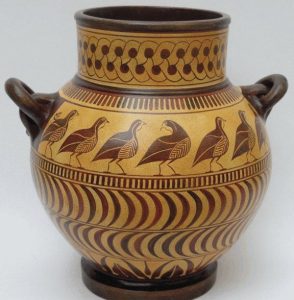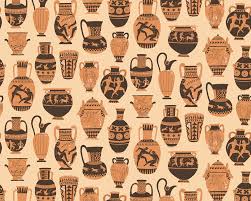Ancient Greek Pottery Designs: The history of ancient Greek pottery is divided stylistically into periods: The Protogeometric from about 1050 BC. The Geometric from about 900 BC. The Archaic from about 750 BC. The Black figure from the early 7th century BC. The Red figure from about 530 BC.

Ancient Greek Pottery Designs
Pottery is one of the most durable materials and even when broken, the pieces of a pot can usually be put together again. This means that pottery is one of the most important sources of evidence for ancient Greece, whether for contacts within the Greek world, artistic influences from other cultures or for dating archaeological sites.
An added bonus of much Greek pottery is that it carries figure scenes which provide information about many aspects of Greek life.
What were Greek vases used for
Almost all Greek pots were made in functional shapes for particular purposes even if they were not actually used for that purpose – some pots were also made specifically to be buried in tombs and graves. Pots could be decorated with scenes from myths and legends or with scenes from everyday life.

Painted Greek vases are known from the second millennium B.C. until almost the end of the first century B.C., and pottery was produced from one end of the Greek world to the other. In the beginning, many local styles flourished, but by the middle of the sixth century B.C. the vases of Attica and its capital Athens had exceeded in quantity and quality those of their nearest rival Corinth, with whom they had been competing for the lucrative foreign markets.
Greek Pottery Shapes
Painted vases were often made in specific shapes or (Specific Ancient Greek Pottery Designs) for specific daily uses storing and transporting wine and foodstuffs (amphora), drawing water (hydria), drinking wine or water (Kantharos or kylix), and so on for special, often ritual occasions, such as pouring libations (lekythos) or carrying water for the bridal bath (loutrophoros).
Their pictorial decorations provide insights into many aspects of Athenian life and complement the literary texts and inscriptions from the Archaic and, especially, Classical periods.

Crete is an island in the Mediterranean Sea. It is part of Greece but lies about 80 miles south-east of the Greek mainland. Crete is an isolated island, and the people have to work hard to make a living. Farmers rear sheep and goats and grow grapes, almonds, olives, oranges, lemons, and grapefruit.
By 3000 B.C., the inhabitants of Crete had reached a Stone Age level of culture. But after that time Crete began to develop rapidly. By 2000 B.C., it was a highly civilized place, with thriving towns, potteries and metal industries.
The Cretans also developed a form of picture writing, similar to that of Ancient Egypt. From that, they evolved an alphabet – the earliest-known writing in Europe.